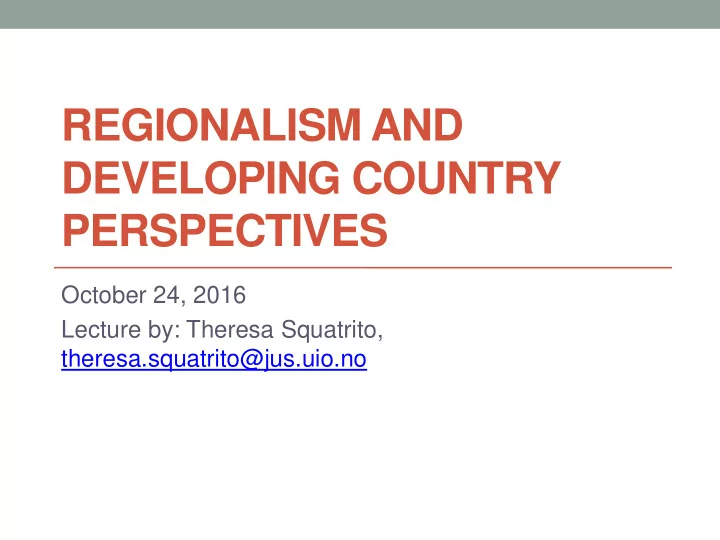

REGIONALISM AND DEVELOPING COUNTRY PERSPECTIVES October 24, 2016 Lecture by: Theresa Squatrito, theresa.squatrito@jus.uio.no
Regional Trade Agreement (RTAs) Definition (WTO): reciprocal trade agreements between two or more partners. Regional trade exceptions to WTO members: • GATT Art XXIV • GATS Art V • They include customs unions and free trade agreements • Customs union: what is it? • Free trade agreement: what is it? https://www.wto.org/english/tratop_e/region_e/rta_participation_ map_e.htm
State of RTAs in trade regime Source: WTO, http://rtais.wto.org/UI/publicsummarytable.aspx (accessed 4 November 2016) What observations do you make? The following table shows all RTAs in force, sorted by Type of Agreement: Enabling clause GATS Art. V GATT Art. XXIV Grand total Customs Union 8 11 19 Customs Union - Accession 1 9 10 Economic Integration Agreement 136 136 Economic Integration Agreement - Accession 6 6 Free Trade Agreement 15 220 235 Free Trade Agreement - Accession 1 2 3 Partial Scope Agreement 16 16 Partial Scope Agreement - Accession 1 1 Grand total 42 142 242 426 The following table shows all physical RTAs in force, sorted by Coverage: Goods 132 Services 1 Goods and Services 135 Grand total 268
RTAs (cont’d) • As of 1 July 2016, 635 notifications of RTAs had been received by the GATT/WTO. Of these, 423 in force. • 435 under GATT XXIV • 43 under Enabling Clause • 157 under GATS V • 90% are FTAs or partial scope agreements, while customs unions account for 10% • Most are bilateral RTAs; currently only 48 plurilateral • Can be cross-region, which are becoming more common. • More commonly cover trade in goods or good and services than services (alone)
Proliferation of RTAs • 1948-1994: GATT received 124 notifications of RTAs (trade in goods only) • Since the creation of the WTO in 1995, 400+ additional arrangements have been notified (trade in goods or services) • Recently, several plurilateral RTAs in negotiation or recently negotiated.
Source: WTO., https://www.wto.org/english/tratop_e/region_e/regfac_e.htm (accessed October 2016)
• Why has there been a proliferation? • Effects of RTAs?
Differences among RTAs • What are some of the ways they vary? • Bilateral vs. Plurilateral • Depth of integration • Degree to which “behind -the- border” provisions are included to address domestic policies, such as intellectual property, competition, investment, environment and labor standards, are included • Shallow: only “one the border measures” • Degree of legalization • Degree to which RTAs are designed to have legalized mechanisms for resolving disputes and enforcing compliance.
Source: James McCall Smith (2000). The Politics of Dispute Settlement Design: Explaining Legalism in Regional Trade Pacts. International Organization, vol. 54(1), p. 143
Source: Alter, K. 2014, The New T errain of International Law. Princeton University Press
Overlapping Jurisdictions: WTO and RTA • WTO DSM has “compulsory and exclusive jurisdiction” over WTO law (Art. 23 of DSU) • RTAs often have choice of forum clauses • Have seen some instances of forum shopping or like cases arising in more than 1 forum • Should we be worried? • Disadvantages of overlap • Advantages of overlap
Developing Countries in WTO Preferential Trade Agreements (PTAs) (or special and differential treatment) • Definition (WTO): non-reciprocal (unilateral) preferential schemes • WTO law allows for PTAs • Generalized system of preferences for developing countries • Enabling Clause (1979 Decision on Differential and More Favorable Treatment, Reciprocity and Fuller Participation of Developing Countries) • Or by waiver from WTO General Council (e.g., Canada with Caribbean nations) • http://ptadb.wto.org/SearchByCountry.aspx
Preferential Trade Agreements (PTAs) • WTO law allows for PTAs (or special and differential treatment) • Definition (WTO): non-reciprocal (unilateral) preferential schemes • Generalized system of preferences for developing countries • Enabling Clause (1979 Decision on Differential and More Favorable Treatment, Reciprocity and Fuller Participation of Developing Countries) • Or by waiver from WTO General Council (e.g., Canada with Caribbean nations) • http://ptadb.wto.org/SearchByCountry.aspx
Barriers for Developing States to Participate in WTO • What are the barriers to the participation of developing countries in WTO trade negotiations? • Who participates mostly in the WTO dispute settlement system? What are the barriers to the participation of developing countries in WTO dispute settlement system? • Possible remedies?
Disputes between members https://www.wto.org/english/tratop_e/dispu_e/dispu_maps_e.htm?country_selected=ATG&sense=e
Recommend
More recommend